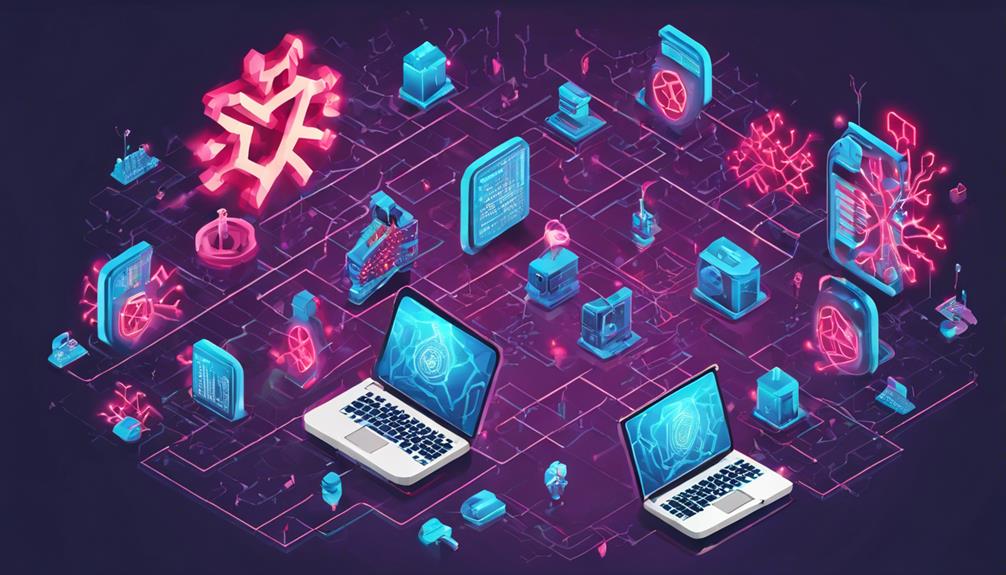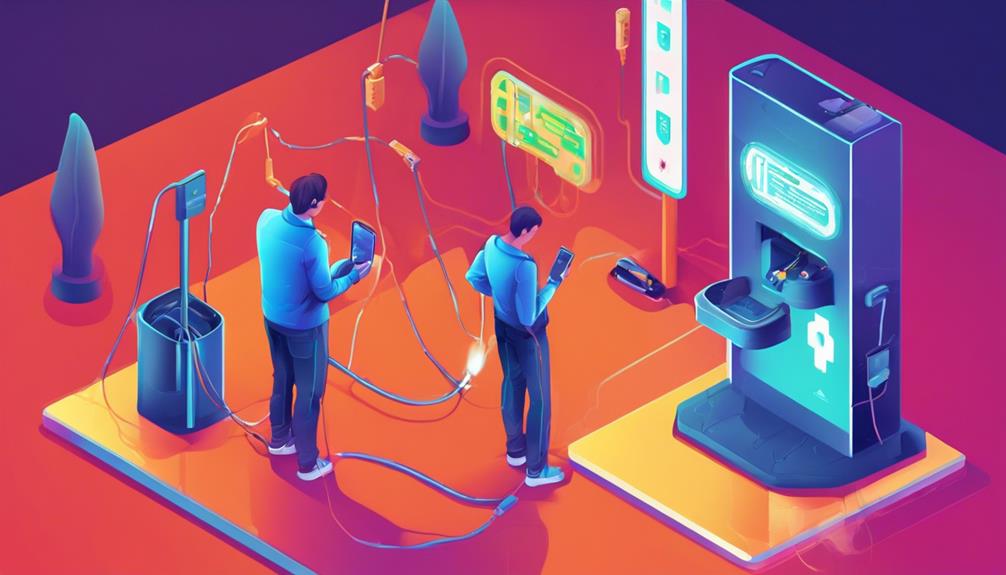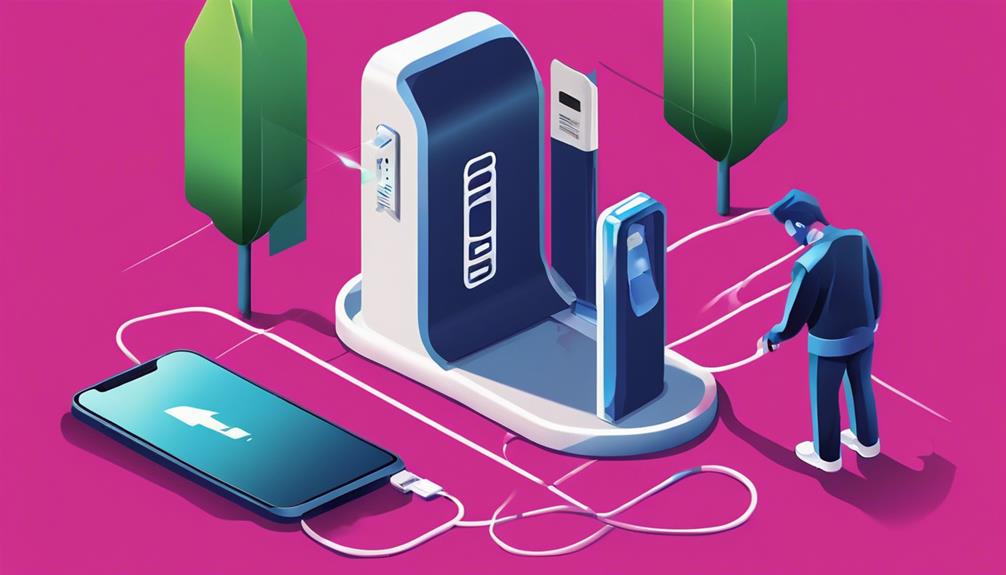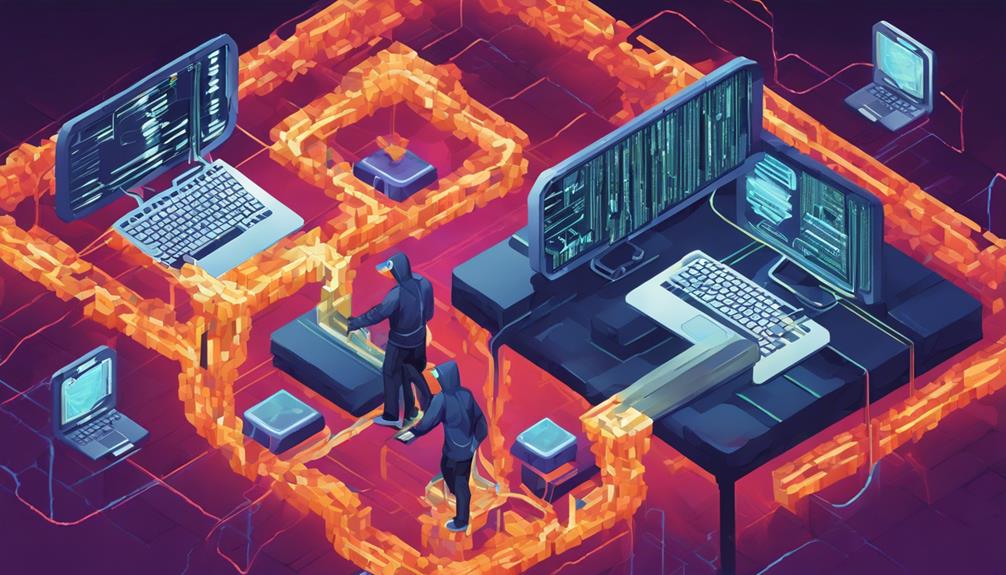Cyber threats like AI-powered malware, virtual kidnapping scams, and deepfake identity theft are evolving dangers. Email spoofing, IoT device hijacking, and USB Rubber Ducky exploits pose risks. Man-in-the-Disk attacks and DNS tunneling breaches compromise data security. Awareness, proactive security measures, and staying informed are vital defenses. Protect against SIM card swapping and juice jacking threats with vigilance. Combating these threats requires understanding, updating devices, and monitoring for suspicious activities. Safeguarding personal data and preventing data breaches demand attention. The cybersecurity landscape is complex, requiring continuous effort to stay protected.
Key Takeaways
- Beware of AI-powered malware using advanced algorithms to breach defenses.
- Guard against virtual kidnapping scams manipulating personal information for ransom.
- Stay vigilant against IoT device hijacking by securing passwords and updating firmware.
- Protect against deepfake identity theft with detection tools against realistic fake content.
- Prevent USB Rubber Ducky exploits mimicking keyboards for data theft.
Email Spoofing Attacks
Email spoofing attacks, a prevalent form of cyber threat, involve the deceptive practice of impersonating a trusted sender to manipulate recipients into taking harmful actions. Attackers manipulate email headers to make messages appear legitimate, tricking individuals into revealing sensitive information or clicking on malicious links.
This form of cyber deception can have severe consequences, including financial loss, data breaches, and compromised sensitive information. To combat email spoofing, organizations can implement security protocols such as SPF, DKIM, and DMARC. These protocols help verify the authenticity of emails and prevent unauthorized parties from sending messages on behalf of trusted domains.
Additionally, training employees to identify phishing emails is essential in mitigating the risk of falling victim to email spoofing attacks. By educating staff members on how to recognize suspicious email characteristics and sender inconsistencies, organizations can strengthen their overall cybersecurity posture and reduce the likelihood of successful email spoofing incidents.
AI-Powered Malware

AI-powered malware represents a new frontier in cyber threats, utilizing artificial intelligence algorithms to outsmart traditional defenses. These malicious programs, equipped with evolving capabilities and neural networks, pose a formidable challenge to cybersecurity.
Detecting and defending against AI-powered malware demands a proactive approach and sophisticated security measures.
AI Threat Detection
Sophisticated cyber threats leveraging artificial intelligence present a formidable challenge for traditional detection methods, highlighting the critical need for advanced AI threat detection capabilities.
AI-powered malware is designed to outsmart conventional security measures, posing a significant risk of data breaches and various cyber threats. This advanced technology can imitate human behavior, adapt to its surroundings, and modify its strategies to bypass security protocols effectively.
To combat these evolving threats, the development and implementation of AI threat detection tools have become essential. These tools play a crucial role in identifying and mitigating the dangers posed by AI-powered malware in real-time.
Cybersecurity experts are continually enhancing their AI-driven solutions to proactively address the ever-changing landscape of cyber threats. Securing systems with AI-based security measures is necessary to safeguard against the persistent and sophisticated nature of modern cyber attacks.
Malicious Neural Networks
The emergence of Malicious Neural Networks poses a critical threat to cybersecurity due to their AI-driven capabilities to craft and deploy evasive malware. These sophisticated neural networks, employed by cybercriminals, utilize artificial intelligence to develop malware that can adapt and learn, making detection and mitigation challenging.
By automating the creation and dissemination of malicious software, these AI-powered malware tools greatly enhance the efficiency and stealth of cyber attacks. Cybercriminals leverage the power of AI technology to create malware that can bypass traditional security measures, posing a substantial risk to individuals and organizations alike.
Protecting against these malicious neural networks requires advanced cybersecurity measures that can effectively detect and counter evolving AI-based threats. As cyber threats continue to evolve, staying vigilant and implementing robust cybersecurity strategies are essential in safeguarding sensitive data and systems from the dangers posed by these innovative malicious neural networks.
Evolving AI Attacks
With the increasing integration of artificial intelligence in cyber threats, a new era of evolving AI attacks is reshaping the landscape of cybersecurity. AI-powered malware utilizes sophisticated algorithms to bypass traditional security measures, constantly adapting and learning to enhance its evasiveness.
These attacks are particularly concerning due to their ability to target diverse sectors like financial institutions, healthcare, and government agencies, posing a severe risk to data security. Experts are warning about the escalating use of AI in cyber attacks, highlighting the potential for highly effective and destructive malware.
Defending against AI-powered threats necessitates advanced cybersecurity strategies, including the implementation of AI-based defense systems to counter these evolving tactics effectively. Social engineering and ransomware attacks are key components of these AI threats, emphasizing the importance of staying vigilant and adopting robust security measures to safeguard against the ever-evolving nature of AI-powered malware.
Virtual Kidnapping Scams

Amid the growing prevalence of cyber threats, one particularly alarming scheme that has emerged is virtual kidnapping scams. These scams involve scammers falsely claiming to have abducted a loved one and demanding ransom money for their release. Leveraging social engineering tactics, scammers aim to instill fear and panic in their victims, making them more susceptible to compliance.
By using personal information obtained from various sources, such as social media, scammers enhance the credibility of their claims, making the situation appear more vital.
In the face of such scams, individuals are advised to remain calm, verify the safety of their loved ones, and promptly report the incident to law enforcement. Heightened awareness and caution are essential in safeguarding oneself against falling victim to these deceitful schemes.
IoT Device Hijacking

IoT device hijacking poses serious risks to personal data and security, as hackers can exploit vulnerabilities to gain control of smart devices in homes.
To prevent unauthorized access, it is essential to change default passwords and regularly update firmware on IoT devices.
Risks of IoT
Safeguarding against the growing threat of IoT device hijacking is paramount in today's interconnected world. IoT devices, ranging from smart thermostats to security cameras, pose significant risks when it comes to data security. Hackers exploit vulnerabilities in these devices to gain unauthorized access, potentially compromising sensitive personal information.
Once compromised, these devices can be used as entry points to infiltrate home networks, leading to data breaches and privacy violations.
To mitigate the risks associated with IoT devices, it is important to take proactive measures. Changing default passwords to unique, strong ones and regularly updating device firmware can enhance security. Additionally, setting up a separate network specifically for IoT devices can isolate them from the main network, reducing the likelihood of a breach spreading.
Being vigilant about IoT security and staying informed about potential threats are essential practices in safeguarding personal data in an increasingly connected world.
Prevention Measures
With the increasing prevalence of IoT devices in households and businesses, implementing preventive measures against IoT device hijacking is essential to safeguard personal data and privacy. Hackers can exploit vulnerabilities in IoT devices to gain control, potentially leading to identity theft and privacy breaches.
To prevent IoT device hijacking, it is vital to change default passwords regularly and update firmware to patch security holes. Additionally, creating a separate network specifically for IoT devices can help isolate potential security breaches and protect sensitive information from unauthorized access.
IoT device hijacking poses a significant risk as hackers can manipulate connected devices without permission, emphasizing the need for strong security measures. By implementing these preventive measures, individuals and businesses can enhance the security of their IoT devices and reduce the likelihood of falling victim to identity theft and privacy violations.
Impact on Security
The repercussions of unauthorized access to connected devices in homes and businesses are an important concern in the field of cybersecurity. Hackers exploit vulnerabilities in IoT devices to gain control, compromising personal data and privacy. Preventing IoT device hijacking involves changing default passwords, updating firmware regularly, and creating separate networks for these devices to enhance security. The table below illustrates key points about IoT device hijacking and its impact on cybersecurity:
| IoT Device Hijacking Impact | Measures to Enhance Security |
|---|---|
| Hackers control devices, access data | Change default passwords |
| Privacy compromise | Regular firmware updates |
| Risk to personal information | Create separate IoT network |
| Requires proactive security measures | Vigilance in securing devices |
| Prevents unauthorized access and breaches | Stay updated on cybersecurity |
Protecting IoT devices is vital in preventing cyber threats and safeguarding personal information. Stay informed and proactive to mitigate the risks associated with IoT device hijacking.
Deepfake Identity Theft

Essential theft through deepfake technology poses a pervasive threat to individuals and organizations alike. Deepfake technology enables the creation of highly realistic fake videos and audio, which can be used to impersonate individuals and commit identity theft.
Hackers utilize deepfakes to manipulate public opinion, spread misinformation, and even blackmail individuals by creating deceptive content, leading to severe consequences for victims. To protect against deepfake identity theft, it is vital to verify the authenticity of media content, employ deepfake detection tools, and stay informed about the latest technological advancements in this field.
The potential for deepfake technology to undermine personal and organizational security is significant, emphasizing the importance of vigilance and proactive measures. By being cautious of the content we consume and implementing strategies to mitigate deepfake risks, individuals and entities can better safeguard themselves against the growing threat of identity theft through deepfake technology.
SIM Card Swapping

SIM card swapping is a technique used by hackers to gain control of a victim's phone number, enabling them to intercept communications and potentially access sensitive accounts.
The implications of such a breach can be severe, compromising personal privacy and security.
To prevent SIM card swaps, individuals should consider setting up additional security measures like PINs or passwords on their mobile carrier accounts.
SIM Card Vulnerability
Amid the rising concerns of cyber threats, one prevalent vulnerability that individuals should be aware of is SIM card swapping. This technique involves hackers deceiving mobile carriers into transferring a victim's phone number to a new SIM card under their control.
Once successful, hackers can intercept calls, texts, and gain access to linked accounts, jeopardizing sensitive information security. To mitigate this risk, setting up a PIN or password on your mobile carrier account can be an effective preventive measure.
Being alert to unexpected loss of phone signal, which might indicate a SIM swap, is essential. Immediate action should be taken to secure accounts in such situations.
It is vital to remain vigilant against SIM card swapping as it can lead to severe consequences such as identity theft and unauthorized access to sensitive data. Stay informed and proactive to safeguard against this insidious cyber threat.
Implications of Swapping
In light of the growing sophistication of cyber threats, the implications of SIM card swapping are increasingly alarming for individuals' digital security.
SIM card swapping involves hackers deceiving mobile carriers to transfer a user's number, allowing access to calls, texts, and linked accounts. By executing a successful swap, attackers can seize control of personal information and accounts, potentially leading to identity theft, financial loss, and compromised online security.
To protect against unauthorized SIM card swaps, setting up a PIN or password on your carrier account is essential. If you experience an unexpected loss of phone signal, it could indicate a SIM card swap, requiring immediate action to secure your accounts.
It is essential to remain vigilant and take preventative measures to safeguard against the serious threat posed by SIM card swapping.
Preventing SIM Card Swaps
To enhance your mobile security and safeguard against unauthorized access to your personal information, implementing additional authentication measures on your mobile carrier account is essential in preventing SIM card swaps.
SIM card swapping is a method used by hackers to deceive mobile carriers into transferring a victim's phone number to a new SIM card. This unauthorized transfer grants hackers access to calls, texts, and linked accounts associated with the victim's phone number.
By setting up a PIN or password on your mobile carrier account, you can add an extra layer of security to prevent SIM card swaps. It's important to remain vigilant for any unexpected loss of phone signal, as this could indicate that a SIM swap has occurred without your knowledge.
If you suspect a SIM swap has taken place, contact your mobile carrier immediately to report the issue and take the necessary steps to secure your accounts. Being proactive in protecting your mobile security can help prevent unauthorized access to your personal information and phone calls.
USB Rubber Ducky Exploits

The utilization of USB Rubber Ducky devices poses a significant threat to cybersecurity due to their ability to mimic keyboards and execute pre-programmed malicious commands. This makes them a potent tool for cyber threats and social engineering tactics.
Here are some key points to take into account:
- USB Rubber Ducky is designed to look like a USB flash drive but acts as a keyboard emulator.
- It can bypass security measures by injecting commands rapidly, enabling attackers to exploit vulnerabilities or install malware swiftly.
- Attackers can program the device to steal passwords, exfiltrate sensitive data, or conduct other malicious activities discreetly.
- The device allows for automated attacks on target systems, enhancing its effectiveness in cyber threats.
- Due to its inconspicuous appearance and quick execution of commands, USB Rubber Ducky poses a serious risk to data protection and cybersecurity.
Juice Jacking Threats

How can public USB charging stations pose a significant threat to cybersecurity?
Juice jacking, a malicious technique, involves hackers installing malware onto devices through compromised charging stations to steal data and potentially take control of the connected devices. This threat exposes individuals to the risk of data theft and device compromise, leading to severe consequences for their personal information and device security.
To safeguard against juice jacking, it is advisable to refrain from using public USB charging stations and instead carry personal chargers. Additionally, utilizing power outlets or USB data blockers can help mitigate the risk of falling victim to this cyber threat.
Being aware of the dangers associated with public charging stations is essential in protecting one's information and preventing unauthorized access to their devices. By taking precautionary measures and staying informed, individuals can reduce the likelihood of falling prey to juice jacking attacks.
Man-in-the-Disk Attacks

Man-in-the-Disk attacks exploit vulnerabilities in Android apps, enabling hackers to intercept and manipulate data exchanged between external storage and the applications. These attacks pose a significant risk as they can result in unauthorized access to sensitive information such as login credentials, personal data, and financial details stored on the device.
By intercepting data in transit, hackers can carry out malicious activities like installing harmful apps, stealing personal information, and compromising the integrity of legitimate apps on the device.
To protect against Man-in-the-Disk attacks, Android users can take the following measures:
- Avoid insecure apps that may be susceptible to these attacks.
- Grant minimal permissions to apps to limit their access to sensitive data.
- Keep devices and apps updated with the latest security patches to patch potential vulnerabilities.
- Be aware of the risks associated with data interception on Android devices.
- Adopt best security practices to safeguard personal data and privacy.
DNS Tunneling Breaches

DNS tunneling breaches present a significant threat in the field of cybersecurity, as cybercriminals utilize this method to circumvent security protocols and facilitate the unauthorized transmission of data. By exploiting DNS servers, attackers establish covert communication channels for data exfiltration and unauthorized access. This technique poses a challenge for detection since DNS traffic is often overlooked in traditional security monitoring. Consequently, organizations face the risk of data breaches and compromise of sensitive information, potentially leading to severe repercussions.
To combat these threats effectively, implementing DNS security measures and monitoring DNS traffic are imperative. The table below highlights key aspects of DNS tunneling breaches to enhance understanding and preparedness in safeguarding against such cyber threats:
| DNS Tunneling Breaches |
|---|
| Method used by cybercriminals |
| Bypass security measures |
| Create covert communication channels |
| Data exfiltration and unauthorized access |
| Risks of data breaches and compromised information |
Frequently Asked Questions
What Are the Top 5 Cyber Threats?
In the field of cybersecurity, the top 5 threats plaguing individuals and organizations include deepfake technology, IoT device hijacking, pharming, man-in-the-middle attacks, and social engineering tactics that prey on human vulnerability.
Are There Any Serious Cyber Security Threats Currently Out There?
Serious cyber security threats persist, targeting individuals, businesses, and organizations. Phishing, ransomware, and data breaches remain prevalent, causing financial losses and identity theft. Proactive cybersecurity measures are essential to mitigate risks and safeguard sensitive information.
Have You Learned Anything Unexpected or Surprising in Cybersecurity?
In the domain of cybersecurity, it is essential to stay abreast of evolving threats. One striking statistic is that small businesses face cyber attacks 43% of the time. This underscores the pressing need for robust defense mechanisms across all organizations.
Can You Protect Yourself From a Cyber Attack?
Protecting yourself from a cyber attack involves staying informed about evolving threats, using strong, unique passwords, enabling two-factor authentication, keeping software updated, avoiding suspicious links, and being cautious with sharing personal information online.
Conclusion
In summary, it is vital to stay vigilant against the myriad of cyber threats that exist in our increasingly digital world.
From email spoofing attacks to deepfake identity theft, the dangers are real and ever-evolving.
By educating ourselves on these risks and taking proactive measures to protect our personal information, we can build a strong defense against cyber threats.
Remember, in the digital landscape, knowledge is power. Stay informed, stay safe.









